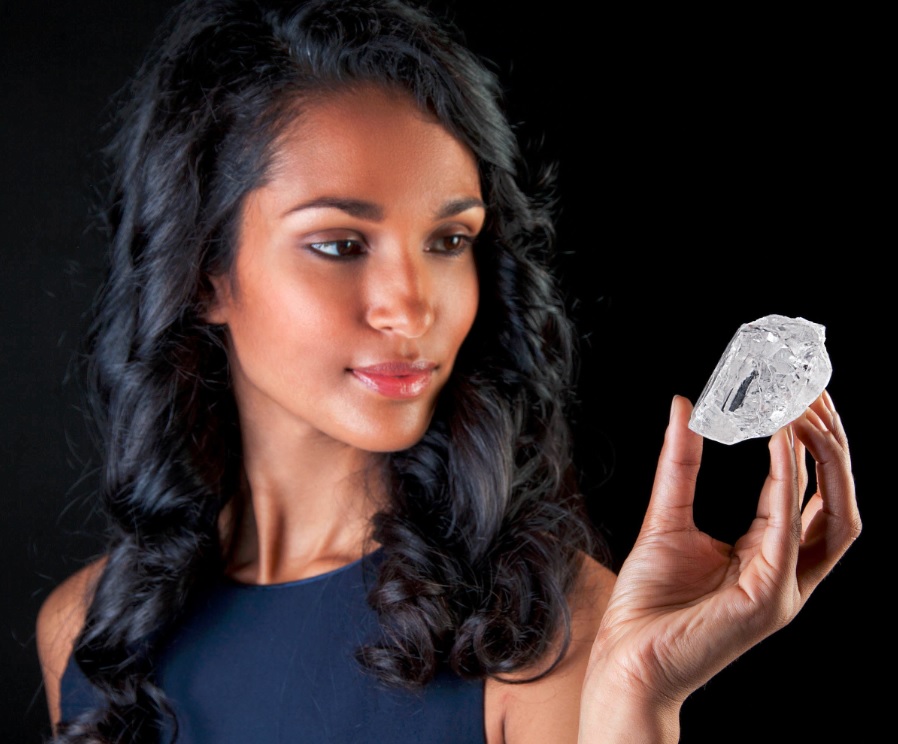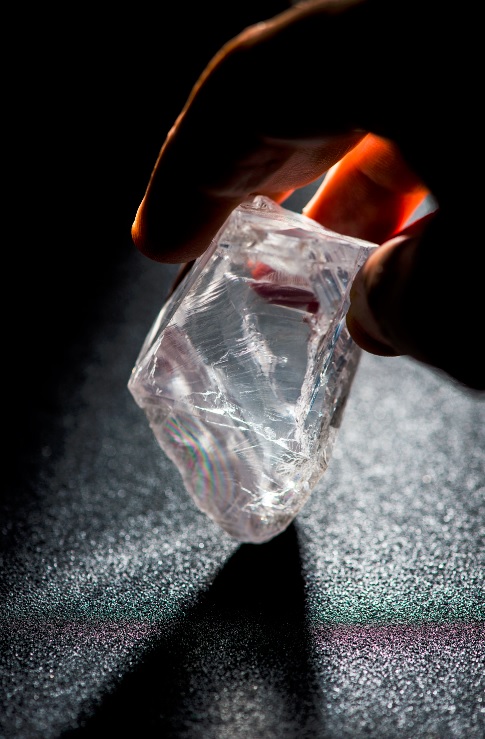|
|
Lucara's Diamond Sale of a Lifetime
Insights
May 11, 2016 12:50 PM
By Avi Krawitz
|
|
|

The 1,109-carat Lesedi La Rona (Courtesy, Sotheby's)
RAPAPORT... In a somewhat underplayed announcement this week, Lucara Diamond Corporation unveiled the most expensive rough diamond ever sold. A short press statement - initially sent without pictures - reported the 812.77-carat stone named ‘The Constellation’ sold for $63.1 million breaking “all records” for a rough diamond.
Ordinarily, Lucara would be making a bigger fuss about this eye-popping sale. But the company, along with the diamond and investment communities, knows this was a mere curtain raiser. The record is bound to be smashed when the 1,109-carat Lesedi La Rona diamond goes under the hammer at Sotheby’s London on June 29.
Sotheby’s set a $70 million pre-sale estimate for the stone, which is acknowledged to be the second-largest rough diamond ever recovered. That assessment now looks conservative in light of The Constellation’s record price-tag.
But while the potential price will certainly get heads turning, there are other aspects of the sale that are significantly adding to the prospect of the Sotheby’s auction.
Sotheby’s Selling Rough
For one, Lucara made the unfamiliar move of handing the 1,109-carat diamond to Sotheby’s to sell. Mining companies tend to sell their rough production in-house while the auction house is better known for its presentation of fine jewelry and special polished diamonds. Indeed, the stand-alone rough auction is “unprecedented,” according to David Bennett, chairman of Sotheby’s jewelry division. “Not only is the rough superlative in size and quality, but no rough even remotely of this scale has ever been offered before at public auction,” he stressed.
William Lamb, Lucara’s chief executive officer, explained the decision in an email to Rapaport News noting the media hype surrounding the stone showed there was more value to be had through a “more public process”.
Simply put, Sotheby’s is expected to bring a marketing prowess and access to potential buyers that Lucara wouldn’t have had on its own.
A Wider Spectrum of Possible Buyers
That opens an interesting possibility private buyers may be bidding against manufacturers for a rough diamond. Or, manufacturers might bid on behalf of a private buyer, with the eventual polished already in mind. And, if a private buys it in partnership with a manufacturer, they’re essentially buying the polished in its rough form so that the polished may not be sold at all in the near term.
Lamb argued as an historic stone and collector’s item, Lesedi La Rona should not necessarily be polished since “it is an amazing piece in its natural form.” He added in a recent conference call there is very strong interest in the stone, not necessarily from the diamond sector, but from probable collectors as well.
There’s certainly a provenance factor that would lure collectors to the auction. After all, the likes of this diamond haven’t been seen since 1905 when the famed Cullinan diamond was unearthed in South Africa in all its 3,106.75-carat glory.
Sotheby’s played up the Cullinan association when announcing the Lesedi La Rona sale, even though there isn’t really a connection beyond that they’re the two largest rough diamonds ever found. It even included an “About the Cullinan Diamond” section in its press release.
Sotheby’s noted that from the Cullinan came the world’s largest facetted white diamond, the 530.20-carat Great Star of Africa, which now sits on the Sovereign Sceptre with Cross. And a second polished stone known as Cullinan II is fitted to the Imperial State Crown. With those spectacular pieces presented as part of the Crown Jewels in London, could Sotheby’s be hinting the Lesedi La Rona is similarly destined for royalty?
Possibilities for Impressive Polished Margins
Therefore, while the sale of these exceptional rough diamonds is currently the talk of the town, there’ll certainly be as much hype, if not more, about the eventual polished. And, if polished, it wouldn’t be surprising to see the diamond reappear at Sotheby’s in the coming years in its new form.
Last year, the auction house sold the 12.03-carat internally flawless Blue Moon diamond for $48.5 million, which, at more than $4 million per carat became the most expensive polished diamond ever sold at an auction. That, after it was cut and polished from a 29.62-carat rough bought from Petra Diamonds for $25.6 million, or $862,780 per carat.
The buyers of Lucara’s rough will be hoping for a similar margin on the resulting polished. After all, both The Constellation (pictured below, courtesy Lucara) and Lesedi La Rona are classified as type IIa diamonds, which leaves a strong possibility they’ll result in high-clarity, high-color graded polished. Sotheby’s noted there’s a “high probability” that the resulting polished from Lesedi La Rona will be D color.
Win-Win for Lucara and Others
All those possibilities add to the excitement surrounding these diamonds, which are proving a windfall for Lucara from a public relations and financial point of view.
 Excluding the two exceptional stones being sold this quarter, the company anticipates a revenue of $200 million to $220 million in 2016, down from $223 million reported last year. The two sales will, therefore, give it a significant bump. They also more than justify the $55 million plant optimization program undertaken at the Karowe mine to install the XRT technology that enabled the discovery of these stones before they could be broken up. Lucara is confident the XRT machines will help it find more such gems in the future. At least investors seem impressed. Lucara’s shares climbed 3 percent after the sale of The Constellation was announced, taking the stock 73 percent above its level at the beginning of the year. As Lamb succinctly put it, “these are exciting times for Lucara shareholders as well as the diamond market.” One might add Botswana to the equation - the country that hosts Lucara’s Karowe mine. Encouragingly, Lamb noted the government will net more than 50 percent of the sales value in royalty and taxes from both stones. Perhaps more important than their value, these diamonds are a source of pride for Botswana, which so heavily depends on the diamond industry. It would be appropriate to raise the country’s profile in the Sotheby’s sale. If anything, these large diamonds can only be used to enhance the image of all involved, including Botswana, Lucara, Sotheby’s and the diamond trade. As Sotheby’s Bennett stressed, the stone is simply “the find of a lifetime.” That makes the upcoming auction – along with its curtain raiser announced this week – as unique as it’s being billed, and certainly worth making a fuss about. The writer can be contacted at avi@diamonds.net. Follow Avi on Twitter: @AviKrawitz and on LinkedIn. |
|
|
|
|
|
|
|
|
|
Tags:
Avi Krawitz, Botswana, Crown Jewels, Cullinan, diamonds, Karowe, Lesedi La Rona, lucara, Rapaport, Sotheby's, The Constellation
|
|
|
|
|
|
|
|
|
|
|

|
|